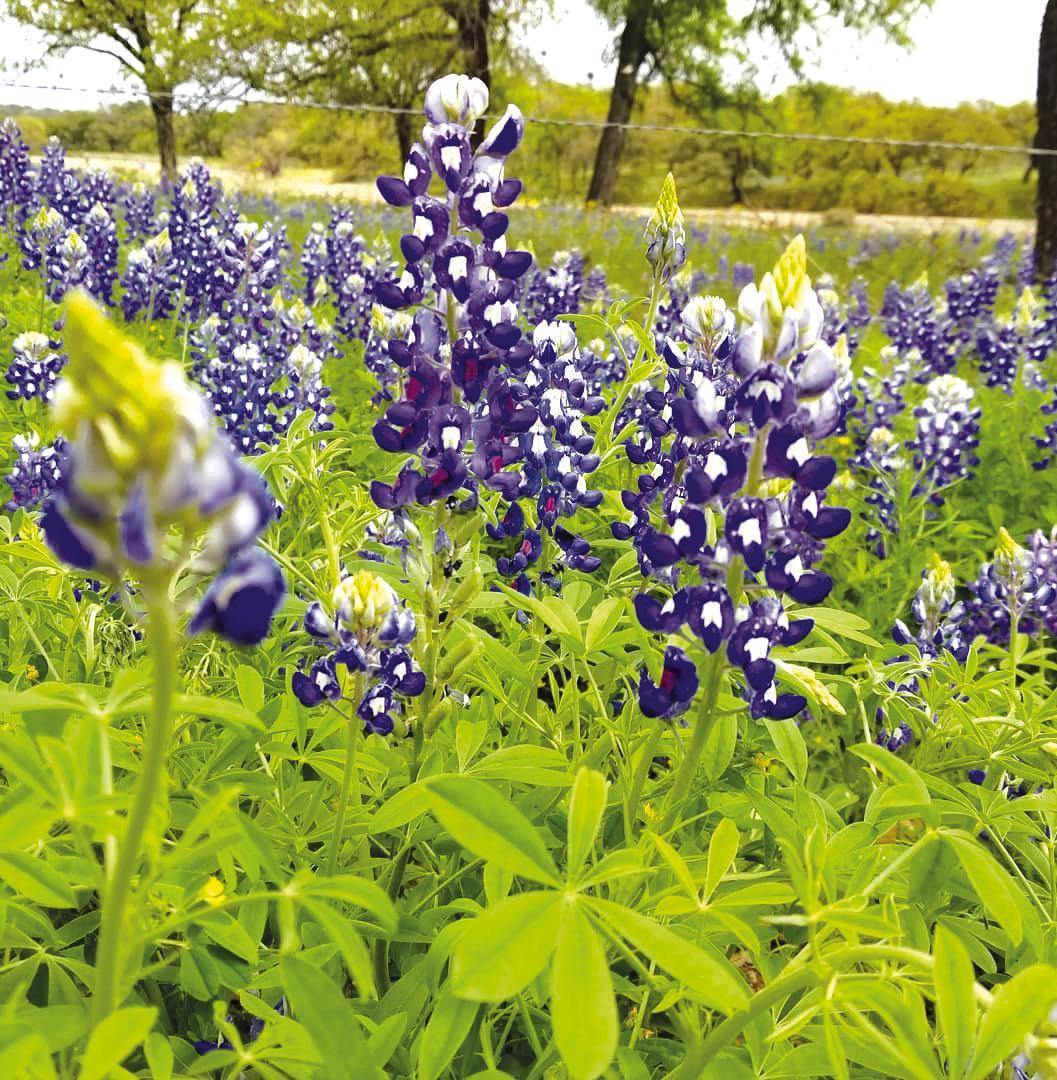
Bluebonnets on the Willow City Loop near Fredericksburg.
Photo by Celeste Cook

SAN MARCOS PUBLIC LIBRARY
625 E. HOPKINS ST.
512-393-8200
Answers to Go
Q. Bluebonnet season is almost here! What can you tell me about bluebonnet history, lore, and where I can see the best bluebonnets?
A. In the 1930s, the Texas Highway Department began a landscaping and beautification program that enhanced the bluebonnet’s range. Due largely to that agency’s efforts, bluebonnets now grow along most major highways throughout the state. Also, thanks to Lady Bird Johnson and many others, the Highway Beautification Act was passed by Congress during LBJ’s presidency. Lady Bird also was the driving force behind the National Wildflower Center in Austin. Check out their website at wildflower. org. A visit to the LBJ ranch in the spring is also a bluebonnet and wildflower treat.
There are several origin stories about the bluebonnet, but the best known is the one told by J. Frank Dobie, the famous Texas folklorist, in “Tales of Old-Time Texas.” J. Frank Dobie has a particular connection to the San Marcos Public Library. His personal office chair — the one in which he sat when writing so many of his books and tales — is part of the Mike Cox Collection housed in the Texas History Room at the library. The bluebonnet origin myth that he wrote about is the same one described in the children’s book by Tomie DePaola, “The Legend of the Bluebonnet.” Both versions (available at the library) are re-tellings of the Comanche Indian legend of how a little girl’s sacrifice brought the bluebonnet to Texas. You can also read a re-telling of the story in Elizabeth Silverthorne’s book “Legends & Lore of Texas Wildflowers” also available at the library.
According to the “Handbook of Texas” (Andrews) on March 7, 1901, the Texas Legislature adopted the bluebonnet, flower of the annual legume Lupinus subcarnosus, as the state flower. The flower’s popular name derives from its resemblance to a sunbonnet. It has also been called buffalo clover, wolf flower, and, in Spanish, el conejo (“the rabbit”) for the white tips of the blossoms resembling rabbit tails. There are at least six different variations of the bluebonnet in Texas, so on March 8, 1971, the legislation was amended to include L. texensis and “any other variety of bluebonnet not heretofore recorded.” You would think that the bluebonnet was the obvious choice as the state flower for Texas, but that was not the case. Initially, Jack Garner, future vice president of the United States, supported the blossom of the prickly pear cactus. Others supported the open cotton boll as the “white flower of commerce” It was not until the Colonial Dames of Texas marshaled their forces to lobby the representatives, and as a visual aid they brought into the House a beautiful bluebonnet painting. The opposition, including “Cactus Jack” Garner, were overwhelmed and the bluebonnet won the day. (Silverthorne) Some folks don’t know that in 1933 the legislature adopted a state flower song, “Bluebonnets,” written by Julia D. Booth and Lora C. Crockett in Chappell Hill, Texas. While there are no recordings of the song with the lyrics that I could find, I did find a flute arrangement of the tune played by the Shimmer Flute Choir of Houston at youtube.com/watch?v=zSjt_mLSXVo
Here are the lyrics:
When the pastures are green in the springtime And the birds are singing their sonnets, You may look to the hills and the valleys And they’re covered with lovely Bluebonnets.
Blue is the emblem of loyalty, They’re as blue as the deep, deep sea, Their smiling faces bring gladness, For they bloom for you and for me. Bluebonnets, so gorgeous and stately, In your mantle of blue and of green, In the spring when you’re in your full glory, You’re the loveliest sight ever seen. You’re beautiful when you sway in the sunshine, You look like waves of the sea, Ah, Texas was wise in her choice of a flow’r, So we offer our homage to thee.
Chorus:
Bluebonnets, blue lovely Bluebonnets, More beautiful than all the rest. Texas chose you for her flower, And we love you best, Bluebonnets.
The oldest bluebonnet trail, which is updated every year, is the one promoted by Ennis, Texas. As their website, bluebonnettrail.org says, “Over 40 miles of mapped driving Bluebonnet Trails”.
• Andrews, J. (1995, May 1). “Bluebonnet.” TSHA. Retrieved March 1 from tshaonline.org/ handbook/entries/bluebonnet • Silverthorne, E. (1996). “Bluebonnets. In Legends & Lore of Texas wildflowers” (pp. 21–25). essay, Texas A & M University Press.
Suzanne Sanders is the columnist for the library. She is the Community Services Manager for the San Marcos Public Library and came from the Austin Public Library in 2015 after having served there as a librarian for over 20 years. She gratefully accepts your questions for this column.











